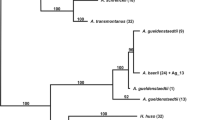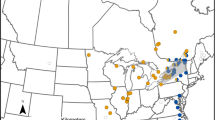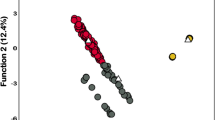Abstract
Pseudorasbora pumila, one of the endangered freshwater minnows in eastern Japan, has been largely replaced by the accidentally introduced species, P. parva, which originated from western Japan. In the contact zone, P. pumila and P. parva have hybridized intensively, producing sterile F1 hybrids. The present study determined the maternal parent of F1 hybrids using mtDNA haplotypes to investigate the mating system between P. parva and P. pumila in the hybrid zone. We also pursued the successive changes in the genetic structures of hybridizing populations over a 5-year period using allozymes. A total of 100 natural F1 hybrids collected from six different populations had P. pumila mtDNA without exception, suggesting that sterile F1 hybrids resulted from mating only between P. pumila females and P. parva males. Such asymmetrical hybridization implies that P. pumila females waste considerably greater reproductive efforts compared with P. parva males. The data suggest that the rapid replacement of P. pumila by P. parva has been promoted by asymmetrical hybridization, resulting in sterile F1 hybrids.
Similar content being viewed by others
References
Allendorf FW, Lundquist L (2003) Introduction: Population biology, evolution, and control of invasive species. Conserv. Biol., 17, 24–30.
Allendorf FW, Leary RF, Spruell P, Wenburg JK (2001) The problems with hybrids: Setting conservation guidelines. Trends Ecol. Evol., 16, 613–622.
Asahida T, Kobayashi T, Saitoh K, Nakayama I (1996) Tissue preservation and total DNA extraction from fish stored at ambient temperature using buffers containing high concentration of Urea. Fish. Sci., 62, 727–730.
Clayton JW, Tretiak DN (1972) Aminecitrate buffers for pH control in starch gel electrophoresis. J. Fish. Res. Bd. Can., 29, 1169–1172.
Ferguson MM (1990) The genetic impact of introduced shes on native species. Can. J. Zool., 68, 1053–1057.
Gill FB (1997) Local cytonuclear extinction of the goldenwinged warbler. Evolution, 51, 519–525.
Goudet J (1995) FSTAT, Version 1. 2: a computer program to calculate F statistics. J. Hered., 86, 485–486.
Hill AM, Lodge DM (1999) Replacement of resident cray shes by an exotic cray sh: The roles of competition and predation. Ecol. Appl., 9, 678–690.
Huxel GR (1999) Rapid displacement of native species by invasive species: effects of hybridization. Biol. Conserv., 89, 143–152.
Katano O, Maekawa K (1997) Reproductive regulation in the female Japanese minnow, Pseudorasbora parva (Cyprinidae). Environ. Biol. Fishes, 49, 197–205.
Kolar CS, Lodge DM (2001) Progress in invasion biology: Predicting invaders. Trends Ecol. Evol., 16, 199–204.
Konishi M, Hosoya K, Takata K (2003) Natural hybridization between endangered and introduced species of Pseudorasbora, with their genetic relationships and characteristics inferred from allozyme analyses. J. Fish Biol., 63, 213–231.
Leary RF, Allendorf FW, Forbes SH (1993) Conservation genetics of bull trout in the Columbia and Klamath river drainages. Conserv. Biol., 7, 856–865.
Levin DA, Francisco-Ortega J, Jansen RK (1996) Hybridization and the extinction of rare plant species. Conserv. Biol., 10, 10–16.
Louis EJ, Dempster ER (1987) An exact test for Hardy– Weinberg and multiple alleles. Biometrics, 43, 805–811.
Maekawa K, Iguchi K, Katano O (1996) Reproductive success in male Japanese minnows, Pseudorasbora parva: observations under experimental conditions. Ichthyol. Res., 43, 257–266.
Ministry of the Environment of Japan (1997) Red List of Threatened Fishes of Japan. Japan Interrated Biodiversity Information system, Tokyo. Available from http://www. biodic.go.jp/english/J-IBIS.html.
Mooney HA, Cleland EE (2001) The evolutionary impact of invasive species. Proc. Natl. Acad. Sci. USA, 98, 5446–5451.
Nakamura M (1963) Keys to the Freshwater Fishes of Japan Fully Illustrated in Colors. Hokuryukan, Tokyo (in Japanese).
Nakamura M (1969) Nippon no koi-ka gyorui (Cyprinid shes of Japan). Research Institute for Natural Resources, Tokyo (in Japanese).
Parker IM, Simberloff D, Lonsdale WM, Goodell K, Wonham M, Kareiva PM, Williamson MH, Holle BV, Moyle PB, Byers JE, Goldwasser L (1999) Impact: toward a framework for understanding the ecological e. ects of invaders. Biol. Invas., 1, 3–19.
Pearson SF (2000) Behavioral asymmetries in a moving hybrid zone. Behav. Ecol., 11, 84–92.
Perry WL, Feder JL, Dwyer G, Lodge DM (2001a) Hybrid zone dynamics and species replacement between Orconectes crayfishes in a northern Wisconsin lake. Evolution, 55, 1153–1166.
Perry WL, Feder JL, Lodge DM (2001b) Implications of hybridization between Introduced and Resident Orconectes Cray shes. Conserv. Biol., 15, 1656–1666.
Randler C (2002) Avian hybridization, mixed pairing and female choice. Anim. Behav., 63, 103–119.
Raymond M, Rousset F (1995) GENEPOP (Version 1. 2): population genetics software for exact tests and ecumenicism. J. Hered., 86, 248–249.
Rhymer JM, Simberloff D (1996) Extinction by hybridization and introgression. Ann. Rev. Ecol. Syst., 27, 83–109.
Ridgway GJ, Sherburne SW, Lewis RD (1970) Polymorphism in the estrases of Atlantic herring. Trans. Am. Fish. Soc., 99, 147–151.
Rozhnov VV (1993) Extinction of the European mink: Ecological catastrophe or a natural process? Lutreola, 1, 10–16.
Sakai AK, Allendorf FW, Holt JS, Lodge DM, Molofsky J, With KA, Baughman S, Cabin RJ, Cohen JE, Ellstrand NC, McCauley DE, O'Neil P, Parker IM, Thompson JN, Weller SG (2001) The population biology of invasive species. Ann. Rev. Ecol. Syst., 32, 305–332.
Sambrook J, Fritsch EF, Maniatis T (1989) Molecular Cloning. Cold Spring Harbor Laboratory Press, New York.
Shapiro LH (1998) Hybridization and geographic variation in two meadow katydid contact zones. Evolution, 52, 784–796.
Southern EM (1975) Detection of specific sequences among DNA fragments separated by gel electrophoresis. J. Mol. Biol., 98, 503–517.
Takahashi H, Takata K (2000) Multiple lineages of the mitochondrial DNA introgression from Pungitius pungitius (L.) to Pungitius tymensis (Nikolsky). Can. J. Fish. Aquat. Sci., 57, 1814–1833.
Takahashi K, Monma Y, Hosoya K, Takatori T, Kiso K (1995) Rediscovery and arti cial reproduction of Pseudorasbora pumila pumila Miyadi from the type locality. Bull. Miyagi Pref. Freshwater Fish. Exp. Stn., 2, 1–9 (in Japanese).
Uchiyama R (1987) Morphology and ecology of Pseudorasbora pumila subsp. Tansuigyo, 13, 74–84 (in Japanese).
Wirtz P (1999) Mother species-father species: unidirectional hybridization in animals with female choice. Anim. Behav., 58, 1–12.
Wolf DE, Takebayashi N, Rieseberg LH (2001) Predicting the risk of extinction through hybridization. Conserv. Biol., 15, 1039–1053.
Author information
Authors and Affiliations
Rights and permissions
About this article
Cite this article
Konishi, M., Takata, K. Impact of Asymmetrical Hybridization Followed By Sterile F1 Hybrids on Species Replacement in Pseudorasbora . Conservation Genetics 5, 463–474 (2004). https://doi.org/10.1023/B:COGE.0000041027.64785.77
Issue Date:
DOI: https://doi.org/10.1023/B:COGE.0000041027.64785.77




